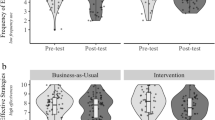Abstract
This study examined the effects of program mode (i.e., a lean program version containing a basic amount of learner practice vs. a full mode containing expanded practice) and learner preference (matched or unmatched) for amount of practice on the achievement, time-in-program, and attitudes of university undergraduate students. Subjects completed a 10-item Likert-type prequestionnaire to indicate the amount of practice they preferred, then were randomly assigned to either the type of program they preferred or to the opposite type. Subjects who used the full version of the instructional program scored significantly higher on the posttest than those who used the lean version. Matching subjects to their preferred amount of practice did not yield a significant achievement difference over assigning subjects to their less-preferred amount. Subjects preferred the lean version of the program over the full one, even though the full version produced better test performance.
Similar content being viewed by others
References
Atkinson, R.C. (1972). Ingredients for a theory of instruction.American Psychologist, 27, 921–931.
Bower, G.H., Thompson-Schill, S., & Tulving, E. (1994). Reducing retroactive interference: and interference analysis.Journal of Experimental Psychology: Learning Memory and Cognition, 20(1), 51–66.
Campbell, C.C. (1993). Accessing related events increases retroactive interference in a matching recognition test.Journal of Experimental Psychology: Learning Memory and Cognition, 19(4), 967–974.
Carrier, C.A. (1984). Do learners make good choices?Instructional Innovator, 29(2), 15–17, 48.
Carrier, C.A., & Williams, M.D. (1988). A test of one learner control strategy with students of differing levels of task persistence.Education Research Journal, 25, 285–306.
Freitag, E.T., & Sullivan, H.J. (1995). Matching learner preference for amount of instruction: An alternative form of learner control.Educational Technology Research and Development, 43(2), 5–14.
Gagné, R.M. (1985).Conditions of Learning and Theory of Instruction (4th ed.). New York: Holt, Rinehart, and Winston.
Gray, S.H. (1987). The effect of sequence control on computer assisted learning.Journal of Computer-Based Instruction, 14(2), 54–56.
Hannafin, R.D., & Sullivan, H.J. (1995). Learner control in full and lean CAI programs.Educational Technology Research and Development, 43(1), 19–30.
Hannafin, R.D., & Sullivan, H.J. (1996). Preferences and learner control over amount of instruction.Journal of Educational Psychology, 88(1), 162–173.
Hicken, S., Sullivan, H., & Klein, J.D. (1992). Learner control modes and Incentive variation in computer-delivered instruction.Educational Technology Research and Development, 40(4), 15–26.
Hintze, H., Mohr, H., & Wenzel, A. (1988). Students' attitudes towards control methods in computer-assisted instruction.Journal of Computer-Assisted Learning, 4(1), 3–10.
Igoe, A.R. (1993).Learner control over instruction and achievement goals in computer-assisted instruction. Unpublished doctoral dissertation, Arizona State University, Tempe.
Jonassen, D.H. (1991). Objectivism versus constructivism: Do we need a new philosophical paradigm?Educational Technology Research and Development, 39(3), 5–14.
Jones, E.E.K., Sullivan, H. J., & Klein, J. D. (1996).Matching preferences for cooperative and individual learning with instructional treatments. Paper presented at the annual meeting of the Association for Educational Communications and Technology, Indianapolis, IN, 1996.
Kinzie, M.B. (1990). Requirements and benefits of effective interactive instruction: Learner control, self-regulation, and continuing motivation.Educational Technology Research and Development, 38(1), 1–21.
Kinzie, M.B., & Sullivan, H.J. (1989). Continuing motivation, learner control, and CAI.Educational Technology Research and Development, 37(2), 5–14.
Kinzie, M.B., Sullivan, H.J., & Berdel, R.L. (1988). Learner control and achievement in science computer-assisted instruction.Journal of Educational Psychology, 80(3), 299–303.
Mager, R.F. (1964). Learner-controlled instruction—1958–1964.Programmed Instruction, 4(2), 1, 8, 10–12.
Mattoon, J.S. (1994).Instructional control in part- and whole-task training. Unpublished doctoral dissertation, Arizona State University, Tempe.
Merrill, M.D. (1975). Learner control: Beyond aptitude-treatment interactions.AV Communications Review, 23, 217–226.
Merrill, M.D. (1980). Learner control in computer based learning.Computers and Education, 4, 77–95.
Pollock, J.C., & Sullivan, H.J. (1990). Practice mode and learner control in computer based instruction.Contemporary Educational Psychology, 15, 251–260.
Popham, W.J. (1969). Objectives and instruction. In W. J. Popham (Ed.),Instructional Objectives. Chicago: Rand McNally.
Ross, S.M., Morrison, G.R., & O'Dell, J.K. (1988). Obtaining more out of less text in CBI: Effects of varied text density levels as a function of learner characteristics and control strategy.Educational Communication and Technology Journal, 36, 131–142.
Ross, S.M., & Rakow, E.A. (1981). Learner control versus program control as adaptive strategies for selection of instructional support on math rules.Journal of Educational Psychology, 73(5).
Shute, V.J. & Gluck, K.A. (1996). Individual differences in patterns of spontaneous online tool use.The Journal of the Learning Sciences, 5(4), 329–355.
Snow, R.E. (1980). Aptitude, learner control, and adaptive instruction.Educational Psychologist, 15, 151–158.
Snow, R.E. & Peterson, P.L. (1980). Recognizing differences in student aptitudes. In W.J. McKeachie (Ed.),New Directions for Teaching and Learning, Cognition, and College Teaching No.2, (pp. 1–23). San Francisco: Jossey-Bass.
Snyder, T. & Sullivan, H. (1995). Cooperative and individual learning and student misconceptions in science.Contemporary Educational Psychology, 20, 230–235.
Sullivan, H., & Higgins, N. (1983).Teaching for Competence. New York: Teachers College Press.
Author information
Authors and Affiliations
Rights and permissions
About this article
Cite this article
Schnackenberg, H.L., Sullivan, H.J., Leader, L.F. et al. Learner preferences and achievement under differing amounts of learner practice. ETR&D 46, 5–16 (1998). https://doi.org/10.1007/BF02299786
Issue Date:
DOI: https://doi.org/10.1007/BF02299786




